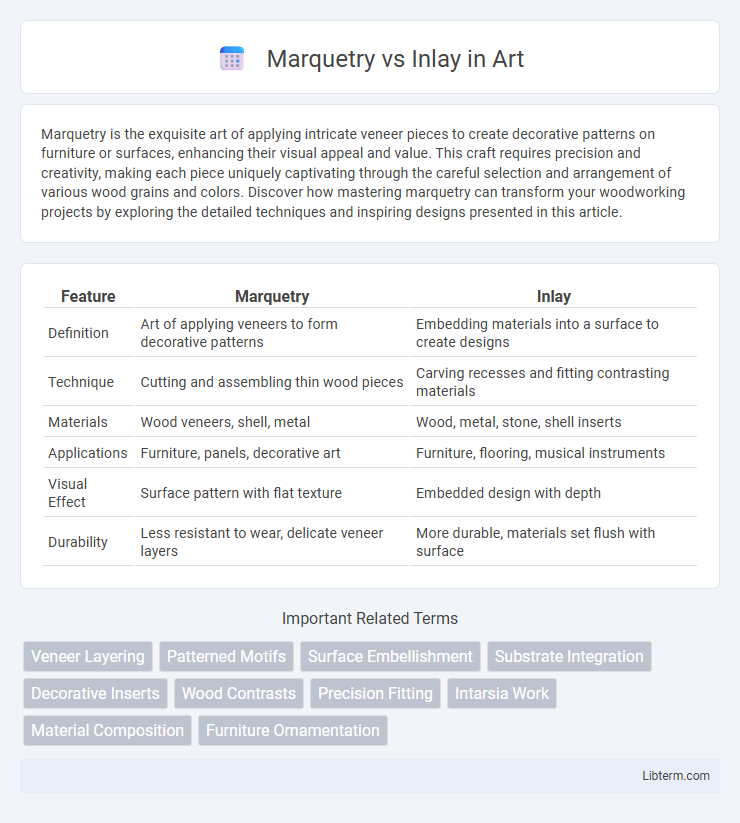Marquetry is the exquisite art of applying intricate veneer pieces to create decorative patterns on furniture or surfaces, enhancing their visual appeal and value. This craft requires precision and creativity, making each piece uniquely captivating through the careful selection and arrangement of various wood grains and colors. Discover how mastering marquetry can transform your woodworking projects by exploring the detailed techniques and inspiring designs presented in this article.
Table of Comparison
| Feature | Marquetry | Inlay |
|---|---|---|
| Definition | Art of applying veneers to form decorative patterns | Embedding materials into a surface to create designs |
| Technique | Cutting and assembling thin wood pieces | Carving recesses and fitting contrasting materials |
| Materials | Wood veneers, shell, metal | Wood, metal, stone, shell inserts |
| Applications | Furniture, panels, decorative art | Furniture, flooring, musical instruments |
| Visual Effect | Surface pattern with flat texture | Embedded design with depth |
| Durability | Less resistant to wear, delicate veneer layers | More durable, materials set flush with surface |
Introduction to Marquetry and Inlay
Marquetry is an intricate woodworking technique where thin veneers of wood, metal, or other materials are precisely cut and assembled to create decorative patterns or images on furniture surfaces. Inlay involves embedding pieces of contrasting materials such as shell, ivory, or metal directly into the wood surface to form detailed designs. Both methods require skilled craftsmanship and enhance the aesthetic appeal of fine woodworking by combining various textures and colors.
Historical Background: Marquetry vs Inlay
Marquetry emerged during the 16th century Renaissance period, often associated with Italian and French craftsmanship, where intricate patterns were created by applying thin veneers of wood, shell, or metal to furniture surfaces. Inlay, a technique dating back to ancient Egypt and Mesopotamia, involves embedding materials such as ivory, mother-of-pearl, or precious stones directly into a solid wood base to create decorative designs. Both methods have been historically valued for enhancing the aesthetic appeal of furniture and architectural elements in different cultural contexts.
Defining Marquetry: Techniques and Materials
Marquetry is a decorative woodworking technique involving the precise assembly of thin veneer pieces to create intricate patterns or images on furniture surfaces, employing materials such as exotic woods, shell, and metal foils. This art form requires cutting and fitting veneers with meticulous accuracy, often using tools like a fret saw or scalpel, to achieve seamless designs that enhance the visual complexity and value of the piece. Unlike inlay, which involves embedding contrasting materials into a solid surface, marquetry relies on the surface application of veneers to form elaborate, pictorial compositions.
Understanding Inlay: Approaches and Applications
Inlay involves embedding contrasting materials such as wood, metal, or shell into the surface of a base material to create decorative patterns, often enhancing furniture, musical instruments, and flooring. Common approaches include flush inlay, where materials are set level with the surface, and relief inlay, which adds dimensional texture. Applications range from intricate geometric designs in cabinetry to artistic motifs in luxury interiors, emphasizing durability and aesthetic contrast.
Key Differences Between Marquetry and Inlay
Marquetry involves creating intricate patterns by applying thin veneers of wood, metal, or other materials onto a surface, forming a picture or design, whereas inlay requires embedding pieces of contrasting material into hollowed-out sections of the base surface for a flush finish. Marquetry typically covers larger surface areas with detailed compositions, while inlay details are often smaller and integrated into the existing material. The precision and technique differ, with marquetry relying on surface layering and inlay demanding precise carving and fitting into recesses.
Types of Materials Used in Marquetry and Inlay
Marquetry primarily uses thin veneers of wood, metal, shell, or mother-of-pearl to create intricate designs on furniture and decorative objects. Inlay involves embedding materials such as wood, ivory, bone, metal, or stone into a solid base surface, often wood, to form contrasting patterns. Both techniques emphasize precision craftsmanship, but marquetry relies on layering thin slices while inlay requires carving cavities to fit the inserted materials seamlessly.
Tools and Skills Required for Each Technique
Marquetry requires precision tools such as veneer saws, scalpel knives, and marquetry frames to cut and assemble thin wood veneers into intricate patterns, demanding high skill in detailed cutting and pattern alignment. Inlay involves carving or routing recesses into a solid wood surface, then fitting contrasting materials like wood, metal, or shell, requiring proficiency with chisels, routers, and fine sanding techniques. Mastery in marquetry emphasizes delicate hand control and design planning, whereas inlay skills focus on accurate carving and seamless material embedding.
Decorative Uses in Furniture and Art
Marquetry and inlay techniques enhance furniture and art by adding intricate decorative patterns using contrasting woods, metals, or shell materials. Marquetry constructs elaborate designs from veneer pieces glued onto surfaces, offering detailed imagery and complex motifs ideal for cabinet doors and tabletops. Inlay involves embedding materials flush into carved recesses, providing subtle accents and durable decoration often seen in fine instrument inlays and ornamental boxes.
Pros and Cons: Marquetry vs Inlay
Marquetry offers intricate, detailed designs created from thin veneers that provide high artistic value but can be fragile and require skilled craftsmanship. Inlay involves embedding materials into a solid surface, resulting in durable, long-lasting patterns suitable for high-traffic areas but with limited design complexity compared to marquetry. Choosing between marquetry and inlay depends on the desired balance between decorative detail and material durability in woodworking or furniture design.
Choosing the Right Technique for Your Project
Choosing between marquetry and inlay depends on the design complexity and material availability for your woodworking project. Marquetry involves creating intricate patterns with thin veneers of wood, ideal for detailed, decorative surfaces, while inlay embeds contrasting materials like wood, metal, or shell into a solid base, perfect for bold, durable accents. Consider the project's surface area, desired visual effect, and budget to select the technique that best enhances your craftsmanship.
Marquetry Infographic

 libterm.com
libterm.com